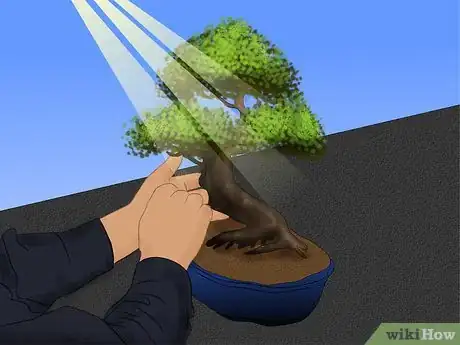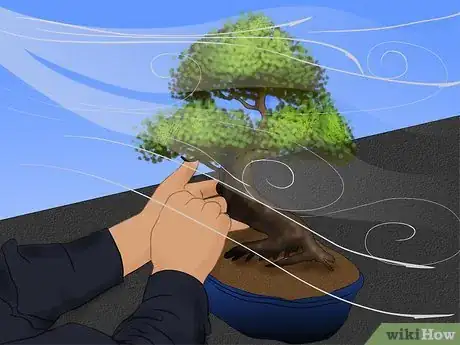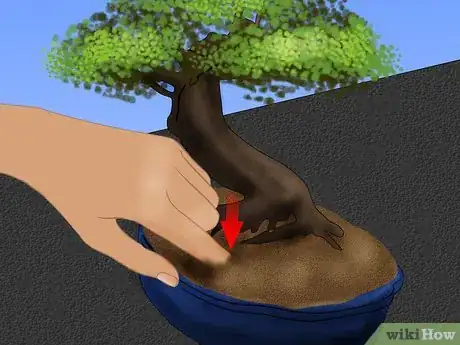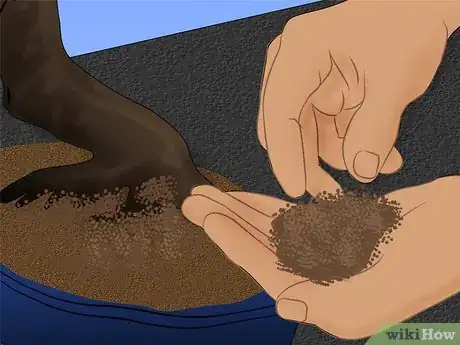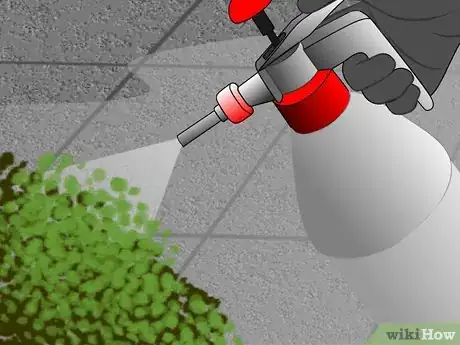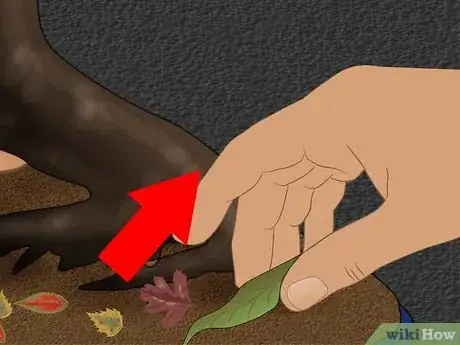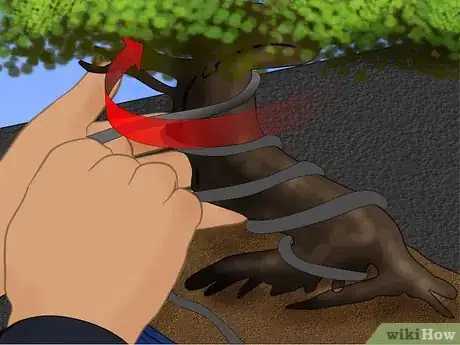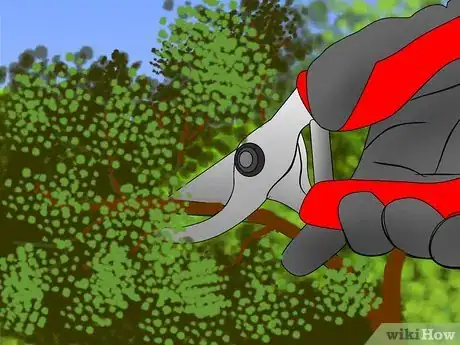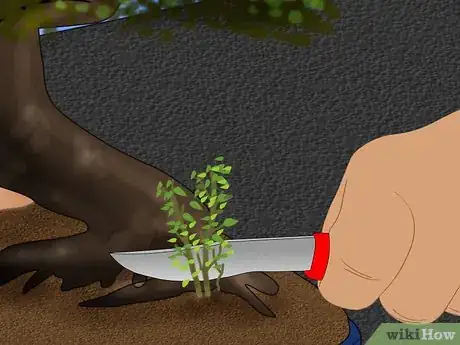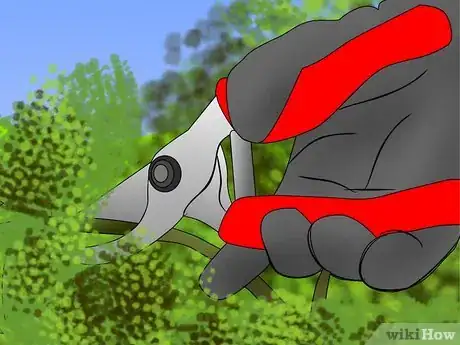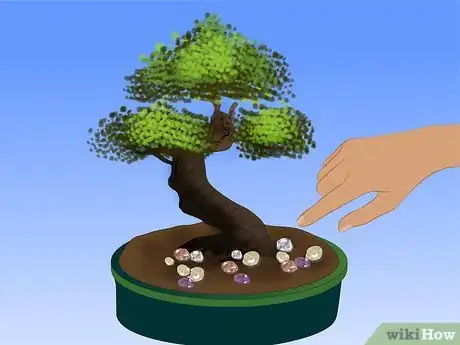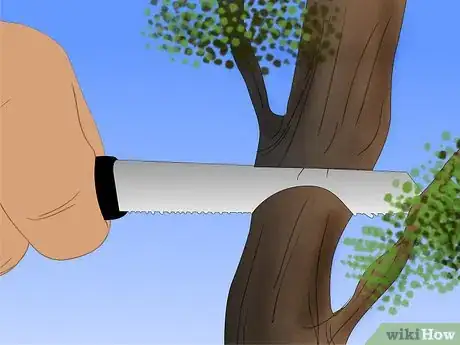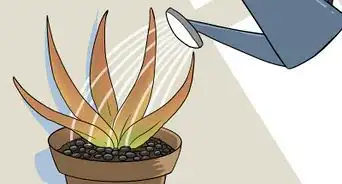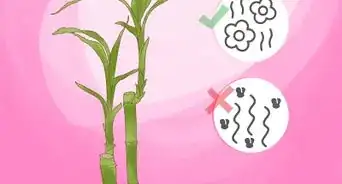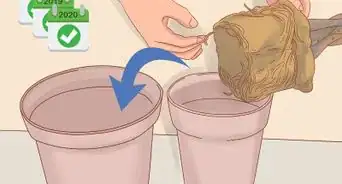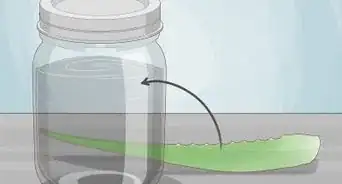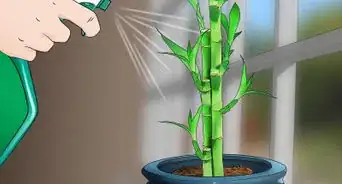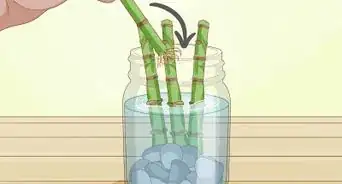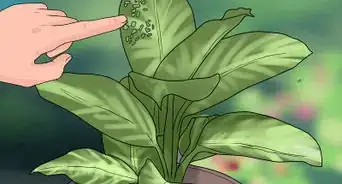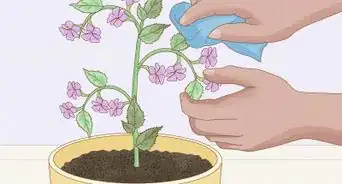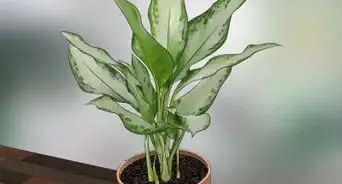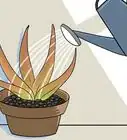wikiHow is a “wiki,” similar to Wikipedia, which means that many of our articles are co-written by multiple authors. To create this article, 12 people, some anonymous, worked to edit and improve it over time.
There are 11 references cited in this article, which can be found at the bottom of the page.
wikiHow marks an article as reader-approved once it receives enough positive feedback. In this case, 95% of readers who voted found the article helpful, earning it our reader-approved status.
This article has been viewed 105,394 times.
Learn more...
The Chinese elm (Ulmus parvifolia), also known as the lacebark elm is among most readily available and most forgiving bonsai trees to work with, making it a great choice for beginners. To care for it properly, keep the tree warm and the soil moist. Prune, train, and repot the bonsai only as needed.
Steps
Environment
-
1Keep the bonsai in a warm location. Ideally, the tree should be kept in temperatures between 15 and 20 degrees Celsius (60 and 70 degrees Fahrenheit).[1]
- During the summer, you can usually keep the bonsai outdoors. You'll need to bring it indoors once temperatures start dropping below 15 degrees Celsius (60 degrees Fahrenheit) during the day and 10 degrees Celsius (50 degrees Fahrenheit) during the night.[2]
- During the winter months, it might actually help the tree if it is consistently kept between temperatures of 10 and 15 degrees Celsius (50 and 60 degrees Fahrenheit). These temperatures are low enough to send the tree into dormancy but high enough to prevent the tree from dying.
-
2Provide plenty of morning sunlight. Place the bonsai in a spot that receives direct sunlight in the morning and indirect sunlight or shade in the afternoon.
- Morning sunlight isn't too intense, but direct sunlight in the afternoon can be too strong and may burn the leaves of the bonsai, especially during the summer months.
- If you decide to move an indoor bonsai outdoors, let it acclimate to direct sunlight slowly to prevent the leaves from burning. Keep it in the sun for longer periods of time day after day until it seems strong enough to spend an entire day in the sun.
- Sunlight also encourages the leaves of the Chinese elm to stay smaller.
Advertisement -
3Maintain good air circulation. Keep the Chinese elm in an indoor or outdoor area that receives plenty of air flow.[3]
- When keeping the bonsai inside, place it in front of an open window or place a small fan nearby to increase the amount of air movement.
- While air circulation is good for the bonsai, you should also note that cold drafts and winds can cause damage. When you keep it outside, position it behind a taller plant or structure to help protect it against nasty gusts.
Daily Care
-
1Allow the surface of the soil to become slightly dry. Stick your finger 1.25 cm (½ inch) deep into the soil. If the soil is dry this deep down, you should give it a little water.[4]
- You will probably need to water the bonsai every day or two during the spring and summer, but this frequency will probably decrease during the late autumn and winter months.
- When you water the bonsai, take it to the sink and let it shower it with water from above. Let the water drain out through the bottom drainage holes several times.
- Bonsai, in general, have a habit of drying out quickly due to the coarse soil and shallow container they grow in.
- Note that specific watering schedules will vary on a case-by-case basis, so you should test the soil for dryness rather than relying on a single schedule.
- You should also consider misting the tree gently once or twice a week. Doing so will keep the soil moist. This routine should not replace regular waterings, though.
-
2Fertilize the bonsai every other week. During the growing season, apply a fertilizer formulated for bonsai trees.[5]
- Note that the growing season is spring through fall.
- Wait until after the bonsai begins to produce new light green growth before you start feeding it with fertilizer.
- Apply a fertilizer that contains equal parts nitrogen, phosphorus, and potassium, as indicated by its formula number (example: 10-10-10).
- If using liquid fertilizer, apply it every two weeks. If using pellet fertilizer, apply it every month.
- Follow the instructions on the fertilizer package to determine the proper amount to use. Most fertilizers should be applied when the plant is being watered.
- Reduce the frequency of feedings once the growth slows down in the mid-to-late summer.
-
3Protect the bonsai against pests. Chinese elm bonsai trees fall victim to the same pests that any house plant can face. Treat the tree with a gentle, organic pesticide as soon as you see signs of a pest problem.[6]
- Your bonsai might have a problem if you notice abnormal leaf dropping or stickiness on the foliage. Visible insects are, of course, another telling sign.
- Mix a solution of 1 tsp (5 ml) liquid dish soap and 1 quart (1 L) tepid water. Spray this mixture on the leaves of the bonsai, then rinse it off with clean water. Repeat this procedure every few days until the problem goes away.
- Neem oil spray can be used instead of a soap solution, if desired.
-
4Watch out for fungal diseases. Chinese elms are especially prone to a fungal disease known as black spot. Treat this or any other disease with an appropriate fungicide as soon as possible.[7]
- Block spot appears as dark spots on the leaves of the bonsai tree. Spray with a fungicide according to label instructions, then remove any leaves that are more than half damaged. Do not mist the tree during this time.
- Depending on the severity of the infection, you may need to treat the bonsai multiple times.
-
5Keep the area clean. Remove dead leaves from the soil as the bonsai naturally sheds them.
- You should also keep dust off the leaves to promote good air circulation.
- Keeping the tree clean is a good way to keep it healthy and protect it against both disease and pests.
Long Term Care
-
1Train the growth using wires. If you want the bonsai tree to grow in a specific form, you will need to train the branches by wrapping wire around them and the trunk of the Chinese elm.[8]
- Wait until new shoots become slightly woody. Do not wire them when they are still fresh and green.
- You can wire the Chinese elm into most bonsai styles, but the classical umbrella shape is recommended, especially if this is your first bonsai.
- To train a bonsai:
- Wrap heavy gauge wire around the trunk of the tree. Wrap thin, light wire around the stems or branches. The branches should still be pliable during this time.
- Wind the wire around at a 45 degree angle and do not wrap it too tightly.
- Bend the wire and its corresponding branches into the shape you desire.
- Readjust the wire every six months. Once the branches are no longer pliable, the wire can be removed.
-
2Trim back new shoots to one or two nodes. Wait until new shoots extend out by three or four nodes, then trim the shoots back to one or two nodes.
- Do not let the branches grow too much longer than four nodes unless you are trying to thicken or strengthen it.
- The frequency with which you need to prune the bonsai will vary on a case by case basis. For best results, do not rely on a strict schedule and simply prune the tree once it starts looking out of shape.
- Pruning new shoots will allow them to divide, ultimately creating a fuller, bushier bonsai rather than a thin, lanky one.
-
3Remove root suckers. Suckers appear at the base of the trunk and should be cut away at soil level as they appear.[9]
- Suckers grow out from the root and deprive the main plant of nutrients.
- If you want to grow a secondary branch or trunk in the area of the sucker, however, you can let it grow instead of removing it.
-
4Prune heavily one month before repotting it.[10] Doing so will give the bonsai enough time to recover from the shock of pruning before undergoing the shock of repotting.
- Note that major pruning is also usually done when the bonsai tree is at its strongest. This means early spring or early summer.
-
5Repot the bonsai when the buds start swelling. Younger trees may need to be repotted every year, while older trees generally need to be repotted every two to four years.[11]
- Repot the plant during the late winter or early spring. Place it into a slightly larger planter with the same quality soil used in its current container.
- Consider spreading a layer of pebbles in the bottom of the container before repotting the tree. These pebbles can prevent the roots from sitting in soil, thereby preventing root rot, as well.
- You can prune the roots as you repot the tree, but avoid any heavy root pruning. The Chinese elm may go into shock if the roots are pruned back too far.
- After placing the bonsai in its new pot, water the soil thoroughly. Keep the bonsai in a shady spot for two to four weeks.
-
6Propagate new bonsai trees from cuttings. You can grow new Chinese elm bonsai trees from 6-inch (15-cm) cuttings taken from established trees in the summer.[12]
- Take the cuttings using sharp, clean scissors.
- Place a fresh cutting in a glass of water. Roots should develop within a few days.
- Repot this cutting in a planter containing two parts loam, one part peat moss, and one part sand. Water regularly until the plant establishes itself.
Community Q&A
-
QuestionIf all of the leaves don't fall off naturally, do I need to cut them off in the winter?
 Community AnswerIt won't hurt to leave them on the tree. However, you should consider removing them if they are still there after the new year. Beeches are notorious for this, and often the new shoots push the old leaves off.
Community AnswerIt won't hurt to leave them on the tree. However, you should consider removing them if they are still there after the new year. Beeches are notorious for this, and often the new shoots push the old leaves off. -
QuestionWhy does a Chinese elm grow fresh leaves and then immediately shed them?
 Community AnswerThis shouldn't happen, and if it does, it indicates that your tree is not getting enough water (or too much) or may be receiving too much heat. Also, check your potting soil to ensure that there is not too much peat. Finally, make sure your tree is firmly seated in its pot, using wire for stabilization if necessary.
Community AnswerThis shouldn't happen, and if it does, it indicates that your tree is not getting enough water (or too much) or may be receiving too much heat. Also, check your potting soil to ensure that there is not too much peat. Finally, make sure your tree is firmly seated in its pot, using wire for stabilization if necessary. -
QuestionDo the leafs fall off in autumn
 Community AnswerYes! Some trees more than others, but when the temperature gets colder and fall rolls around, the leaves fall off onto the ground.
Community AnswerYes! Some trees more than others, but when the temperature gets colder and fall rolls around, the leaves fall off onto the ground.
Things You'll Need
- Small fan
- Water mister or spray bottle
- Sink or watering can
- Balanced (10-10-10) fertilizer
- Organic pesticide (neem oil spray or dish soap solution)
- Fungicide
- Sharp, clean scissors
- Clean pots or planters
- Pebbles
- Coarse soil
- Glass of water
- Loam
- Peat moss
- Sand
- Heavy gauge floral/craft wire
- Light gauge floral/craft wire
References
- ↑ http://www.bonsaioutlet.com/chinese-elm-bonsai-care/
- ↑ https://www.bonsaiempire.com/tree-species/chinese-elm
- ↑ https://www.nebonsai.com/content/Chinese_elm.pdf
- ↑ https://www.nebonsai.com/content/Chinese_elm.pdf
- ↑ http://www.bonsaitoolchest.com/v/vspfiles/caresheets/chinese-elm.pdf
- ↑ https://www.bonsaiempire.com/basics/bonsai-care/advanced/pests-diseases
- ↑ https://www.bonsai-and-blooms.com/bonsai-tree-diseases.html
- ↑ https://www.bonsaiempire.com/basics/styling/wiring
- ↑ https://edis.ifas.ufl.edu/st652
About This Article
Bonsai trees grow best when they get morning sunlight and are watered regularly. To care for your bonsai, place it in a spot that gets direct sunlight in the morning but is protected from it in the afternoon. Afternoon sunlight is often too strong for the tree and can cause its leaves to burn. Water your bonsai every 1 to 2 days during the growing season, which is spring to fall. After the first green shoots appear, start fertilizing the tree every other week with a fertilizer containing equal parts nitrogen, phosphorus, and potassium. Bonsai trees don’t do well in cool temperatures, so you’ll need to keep the tree indoors if it drops below 60 degrees Fahrenheit outside. If the leaves feel sticky or you notice lots of insects on your tree, spray it with a natural pesticide to get rid of the pests. For tips on how to treat black spot disease, read on!

